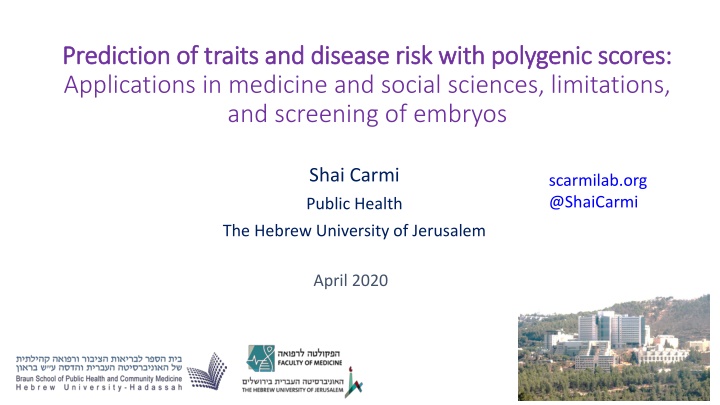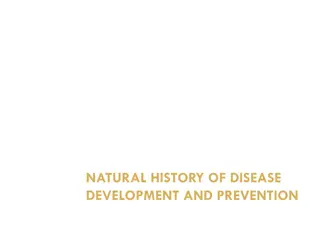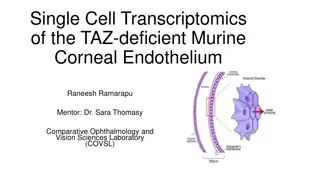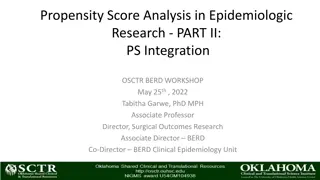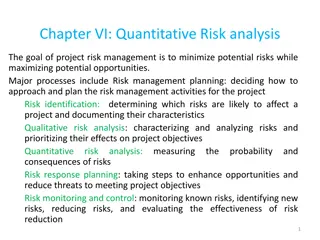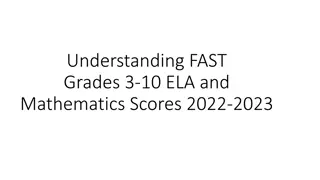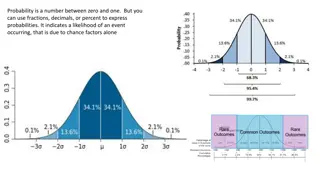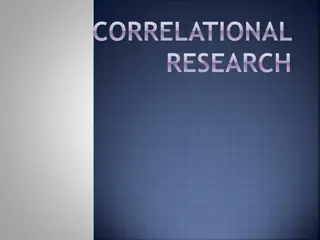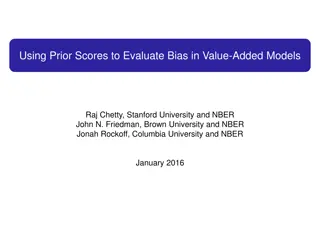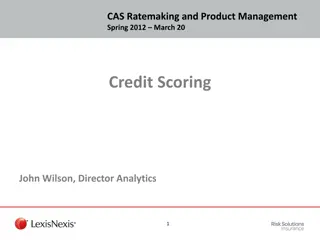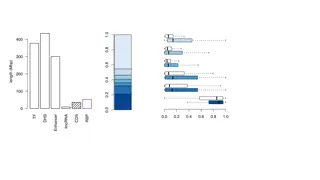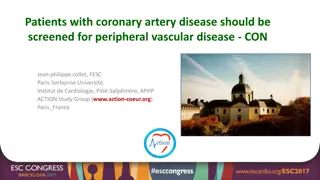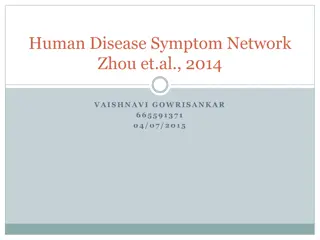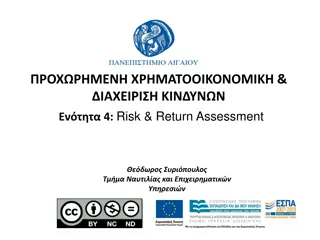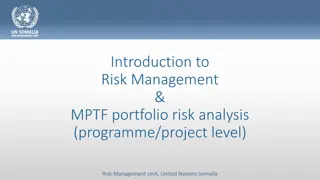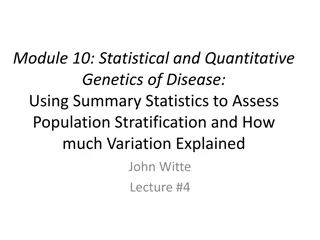Polygenic Scores for Disease Risk: Applications and Limitations
Uncover the impact of polygenic scores on predicting disease risk and traits, their applications in medicine and social sciences, limitations, and potential for embryo screening. Explore complex traits genetics, limitations of polygenic scores, and the process of selecting embryos based on traits. Delve into genome-wide association studies, study designs, statistical issues, and the evolution of genetic research from 2009 to 2019.
Download Presentation

Please find below an Image/Link to download the presentation.
The content on the website is provided AS IS for your information and personal use only. It may not be sold, licensed, or shared on other websites without obtaining consent from the author.If you encounter any issues during the download, it is possible that the publisher has removed the file from their server.
You are allowed to download the files provided on this website for personal or commercial use, subject to the condition that they are used lawfully. All files are the property of their respective owners.
The content on the website is provided AS IS for your information and personal use only. It may not be sold, licensed, or shared on other websites without obtaining consent from the author.
E N D
Presentation Transcript
Prediction of traits and disease risk with polygenic scores: Prediction of traits and disease risk with polygenic scores: Applications in medicine and social sciences, limitations, and screening of embryos Shai Carmi scarmilab.org @ShaiCarmi Public Health The Hebrew University of Jerusalem April 2020
Outline Complex traits genetics and polygenic scores Limitations of polygenic scores Selecting embryos for traits
Questions How to find the genetic basis of traits and diseases? What was discovered? What did we learn about the biology? What can we do with the results?
Genome-wide association studies SNP: single nucleotide polymorphism Phenotype can be binary (case/control) or quantitative Genome Research Ltd.
Study design CFTR Negative selection APOE Traditional family-based linkage studies; consanguineous families GWAS is useful No power Manolio et al., 2009
Study design: technology Genotyping technology: mostly microarrays o 500k-1M common polymorphisms o Markers tag causal alleles via linkage disequilibrium o Cheap: $50-100 per sample o Almost entire genome can be reconstructed with imputation Exome/genome sequencing: detect association of rare variants, mostly coding IMPUTE2
Study design: statistical issues Strict Bonferroni correction: P-value of 5 10-8 required P-value inflation must be visually and statistically evaluated Population structure correction: Account for ancestry differences between cases and controls Manhattan plot Florian Prive
2009: no results Heritability: Proportion of variance in trait explained by genetics Height: o Heritability: 80% o 40 loci associated o 5% of the variance Conjecture: larger sample sizes needed
2019: heritability explained March 2019; height Tam et al., 2019 Claussnitzer et al., 2020
Trait # loci What is now known? Number of children 31,600 Schizophrenia 13,800 College 12,000 Almost all complex traits/diseases are highly polygenic, in particular cognitive/behavioral traits Most associated loci are non-coding Morning person 10,500 Age at first birth 9,800 Neuroticism 9,800 Cardiovascular disease 6,500 Blood pressure 6,500 Pleiotropy is common: genetic correlation between traits BMI 6,000 Inflammatory bowel disease 4,000 Height 3,600 Negative selection reduces frequency of effect alleles Age at menarche 3,000 Asthma 1,300 Alzheimer s disease 800 T2 diabetes 700 From O connor et al., 2019
Discovery prediction Summary statistics are publicly/freely available Trait ? Effect size: Quantitative traits: increase in trait with each allele (regression slope) Disease (binary) traits: log-odds ratio Allele count 0 1 2 Effect size ? SNP Chr Position Effect allele P-value 2 10 5 4 10 3 2 10 8 7 10 4 rs1234 1 134346223 A 0.001 rs2345 3 124572521 G -0.0006 rs3456 6 73422152 A 0.02 rs4567 14 66452342 C -0.003
Polygenic scores (PS) Using summary statistics, we can predict the trait of a new individual ???? ? ?? = ?=1 ?: number of SNPs ??: number of effect alleles at SNP ? (0,1,2) ??: estimated effect size at SNP ? Statistical methods refine the set of SNPs and the weights
SNP selection It is usually advisable to remove correlated SNPs (in linkage disequilibrium) Should we use all SNPs or just significantly associated SNPs? Significant SNPs All SNPs Avoid noise Use just the most relevant SNPs Increase power by including SNPs whose evidence for association is weak only due to the finite sample size
SNP selection Use cross-validation to find the optimal P-value threshold Psychosis Alcohol dependence Barr et al., 2019 Santoro et al., 2018
Performance of polygenic scores 2: proportion of variance explained by genetics (heritability) ??? 2: proportion of variance explained by score 2< 2< 1 ??? ?? ? Trait ??? Height 55-80% 25% BMI 40-70% 10% LDL cholesterol 40-50% 5% Blood pressure 30-50% 4% Educational attainment 30-70% 12% Cognitive function 30-80% 5%
Separation of cases and controls Mavaddat et al., 2015 Lello et al., 2019
Separation of cases and controls Alzheimer s disease Fulton- Howard et al., 2020 Marquez et al., 2016 Cases Controls
Predicting cardiovascular disease risk Khera et al., 2018
More diseases Inflammatory bowel disease Breast cancer Atrial fibrillation T2 diabetes Khera et al., 2018
More phenotypes Kachuri et al., 2020 Severe obesity Khera et al., 2019
Scores also relevant to Mendelian mutations carriers MLH1, MSH2/6, PMS2 BRCA1/2 Fahed et al., 2019
Other key applications Polygenic scores were shown to predict age of onset, severity of disease, and response to treatment The predictive power of the scores often depends on the environment, indicating GxE interaction Mars et al., 2020; Finland
Is there clinical utility? JAMA, 2020 Elliott et al., 2020
Is there clinical utility? A comparison of polygenic scores for 25 diseases using the UK Biobank Kulm et al., 2020
Intermediate summary Polygenic scores associate significantly with common traits/diseases The distribution of scores in cases/controls is distinct Individuals at the highest score percentile have 3-5x higher risk Scores are additive to family history and Mendelian mutations BUT, Prediction accuracy is overall poor Most of the population has intermediate non-informative scores Some scores add little benefit beyond standard risk factors
Personality and behavioral traits Karlsson Linn r et al., 2019 Bar et al., 2019 Peyrot et al., 2014
Interesting results for education scores Harden et al., 2020
Interesting results for education scores Polygenic scores Townsend Deprivation index Kong et al., 2017 Average polygenic score Year of birth Abdellaoui et al., 2019
Outline Complex traits genetics and polygenic scores Limitations of polygenic scores Selecting embryos for traits
Problems with polygenic scores Problems when comparing scores across populations Low predictive accuracy in non-European populations Low predictive power within families Variable predictive power across age, calendar year, and population subgroups
Differences between populations Finland Martin et al., 2017 Kerminen et al., 2018
Are those differences indicative of selection? Robinson et al., 2015
The problem of population structure Cases In large genetic studies, we often sample across multiple populations Sampling may be uneven, due to purely environmental/cultural reasons Controls Any variant with a different frequency between populations (due to neutral genetic drift) will seem associated Sub-population 1 Sub-population 2
Most selection signal is false World-wide study UK biobank Polygenic score Italy Spain UK NW-Eur Latitude Latitude World-wide study UK biobank Berg et al., 2019; Sohail et al., 2019
Population structure is a pervasive problem Educational attainment score (2016)
Lower prediction quality in non-Europeans 22 quantitative anthropometric and blood-panel traits Martin et al., 2019
Lower prediction accuracy within families Own genotype Parental genotype Own Home environment education Higher score Higher score 50% shared Education supporting Cheesman et al., 2019 Educational attainment Unrelateds Within-family Young et al., 2019 SNP heritability Polygenic prediction
Variable predictive power across sex, age, and SES Mostafavi, Harpak, et al., 2020
Variable accuracy across time, location, and age Predicting educational attainment before and after communism +1SD change in score Belsky et al., 2016 Ujma et al., 2020
Outline Complex traits genetics and polygenic scores Limitations of polygenic scores Selecting embryos for traits
Genetic screening of embryos Why? o Mendelian disease mutations o Recurrent pregnancy loss How? o Grow IVF embryos for 3-5 days o Amplify DNA from a single cell What? o Traditionally: single mutations, aneuploidy o Now: whole-genome haplotypes, CNVs o Universal, fast, accurate, low cost
How could it be possible? Embryos are a mosaic of the parents Only need to infer crossover locations (Up to de-novo mutations) Parents (microarray) Embryo 1 Embryo 2 Embryo 3 Array/low-coverage sequencing
Implications Screening embryos for complex traits now feasible At least one company is already offering the test
Screening embryos for complex traits now feasible From GP website: Type 1 and Type 2 Diabetes Coronary Artery Disease, Heart Attack Risk, Hypercholesterolemia, Hypertension Breast Cancer, Testicular Cancer, Prostate Cancer, Malignant Melanoma, Basal Cell Carcinoma Intellectual Disability Idiopathic Short Stature o o o o o December 2019 April 2019
Obviously, ethical concerns MIT Technology Review November 2017 Antonio Regalado The Economist, November 2018 New Scientist, November 2018 The Times, November 2018
No data! Does it work? What are the expected outcomes? So far: economic analysis, no empirical data (Shulman and Bostrom, 2014) Our approach: 1. Simulations based on real data 2. Quantitative genetic model 3. Large nuclear families
Simulations overview Predicted trait Start with real genomes Pair individuals (randomly/real couples) Gain Simulate ? offspring Avg Compute PS and predict trait of offspring Gain = (prediction of top-scoring embryo) (average prediction)
Traits/cohorts Gil Atzmon, Nir Barzilai Einstein College of Medicine Height 102 couples, 700k SNPs Ashkenazi Jews, a longevity study (Sathyan et al., 2018) Cognitive ability (IQ) 919 young males, 480k SNPs Greek schizophrenia study (Stefanis et al., 2004) Nikos Stefanis, Alex Hatzimanolis, Nikolaos Smyrnis, Dimitrios Avramopoulos, University of Athens
Experiments (? = 10 embryos) Gain in height: 2-4 cm Real/random families behave similarly Gain in IQ: 2-4 points Height (real couples) IQ Height (random couples) Density
